Millimeter-wave Metantenna Technologies in 5G and Beyond
Zhi Ning Chen, Department of Electrical and Computer Engineering, National University of Singapore
Abstract
The antenna is one of the most important technologies in all modern wireless networks. The deployment of new wireless systems always creates new technical challenges or opportunities for the development of antenna technologies from radiators to systems. The concepts of metamaterials have broken the boundaries of the conventional EM engineering. In particular, the applications of metasurfaces, a new design concept of two-dimensional EM structures, have offered the new opportunities to the innovative antenna technology. This article addresses the challenges and progress in the development of metamaterial/metasurface-based antennas, metantennas in short, in 5G millimeter-wave bands. Four design examples from 2 cases of flat lenses, a shared aperture to a dual-band metantennas demonstrate the applications of metantennas for 5G network. Of them one example of three-beam metalens antenna operating at 5G New Radio 2-GHz bands is also selected because the design method can be directly extended to the designs at millimeter-wave bands. The success in the applications of metantennas has shown the promising way for developing the antennas for new functionalities and new performance levels in 5G and beyond networks.
1. Challenges and Innovation of Antenna Technologies in 5G and Beyond
The innovations of 5th generation mobile network (5G) are rapidly changing wireless technology from network architecture to unit design (such as antenna technologies) because of the new and ambitious technical and application vision. In particular, new multiple antenna technologies have been the focus of innovation since the early stage of 5G. They include but are not limited to the antennas to support:
- massive multiple input multiple output (mMIMO) systems,
- multiuser-MIMO systems,
- multiple radio access technology systems;
- pattern reconfigurable and beam switchable systems;
- multiple-beam and phased beamsteering systems; and
- aperture sharing systems.
The antenna technology has significantly advanced to more and more complicated systems since 3G mobile network to match to the requirements for larger and larger capacity with huge number of connections and Gbps data-rates for both uplink and downlink, as well as higher and higher resolution and less and less latency for sensing. The requirements for advanced antenna systems have raised the challenges relevant to antennas such as:
- increased antenna design complexity;
- increased antenna system integration complexity and cost;
- increased overall volume, particularly, horizontal size for tower/roof basestation antennas; and
- increased power consumption.
Meanwhile the new spectra with wider bandwidths have been proposed to meet the new performance expectations mentioned above. Besides the new sub-6GHz bands, from 3GPP TS 38.101-1, the bands of n257, n258, n260 and n261 of Frequency Range 2 have been allocated for 5G systems. The available frequency ranges from 24.25 GHz to 40.00 GHz, covering higher K-band and Ka-bands or the lower edge of millimeter-wave (mmW) bands. The shorter wavelengths at mmW bands to some degree ease the challenge of large physical volume of large-scale multiple antenna systems compared to the antenna systems operating at sub-6GHz bands. With the physical limitation of propagation of electromagnetic waves at mmW bands, the antennas used for mmW links are usually high in gain to compensate for high pathloss [1]. Therefore, the high-efficiency antenna or array designs at mmW bands becomes top critical.
2. Innovation of Antenna Technologies: Metantennas
Antenna technology is about a system including radiators or an array of radiators, controlling units, and signal processing [2]. As the hardware, the radiators, namely antennas have been very well developed since Heinrich Hertz’s days. The most important recent innovation of antennas should be the applications of metamaterial concepts in antenna design since later 1990s.
Metamaterial is a general physical concept to describe all artificial structures which electromagnetic properties have been not found in nature. Usually, such structures are described using material parameters such as permittivity, permeability, or refractive index. Its two-dimensional versions, namely metasurfaces are characterized using the parameters such as transmission, reflection, or polarization conversion. The metamaterial concepts have removed the boundary of natural materials so that metamaterial-based antennas, metantennas in short, can be the inventions with new functionalities or enhanced performance of existing designs [3]. For example, either effective permittivity or effective permeability of the structures can range from negative to positive infinite. The metasurface can be used a wave transformer to manipulate the amplitude, phase, and polarization in a large range but through an electrically very small distance (small thickness). With such boundaryless unique properties, the control of electromagnetic wave features more freedom. As a result, this has offered great opportunity for innovative antenna design. So far, it has been well proven that the metantennas can be used to enhance almost all the key performance of existing antennas in terms of, for example,
- miniaturization of antenna volume and lowering antenna profile;
- enhancement of antenna gain with acceptable efficiency;
- widening antenna bandwidth of impedance, gain, and phase responses;
- suppressing mutual coupling between antennas;
- control of antenna radiation patterns by shaping beam, pointing beam, or suppressing sidelobe levels;
- design electrically large current zero-phase-shift loops; and
- control of near-zone magnetic field using artificial magnetic materials with high, zero, or negative permeability.
The metantennas have been successfully applied over whole microwave bands. Here the metantennas invented for 5G mmW operation are exemplified to demonstrate the applications of metantennas. For sure, the technology developed can be naturally scaled down or up for the designs at adjacent bands.
3. Metantennas at 5G mmW Bands: Design Examples
There have been more and more metantenna designs at mmW bands for 5G network [4]. For example, the flat metasurface lenses for high gain, multibeam, and spatial massive MIMO applications, flat metasurface reflectarray, planar metasurface antennas for dual-band operations, shared aperture metasurface antenna, and so on.
3.1 Flat Metasurface Lens
Full dielectric lens antennas usually feature high focusing performance such as high aperture efficiency for high gain, flexibility of multiple functionalities such as the generation of multiple beams, but suffer from bulky and costly three-dimensional design, in particular, at microwave bands. With the metasurfaces, it is possible to flatten the conventional dielectric lenses and fabricate the lenses using printed circuit board (PCB) technology. Metasurface is a two-dimensional arrangement of electrically thin engineering polarized scatterers to control the phase, amplitude, and polarization of EM waves over its surface for desired functions. A dielectric focusing lens achieves the phase distribution to compensate for the phase difference of a spherical EM wavefront using varying dielectric thickness of a lens. Similarly, the unit cells on a metasurface are design to realize varying phase shifts for phase compensation.
Design 1: With metasurfaces a flat multiple beam lens antenna operating at 28 GHz was designed for spatial multiple-input and multiple-output (MIMO) systems as shown in Figure 1 [5]. Figure 1a shows the mechanism of a conventional double-convex dielectric lens. With the varying thickness the lens realizes the phase shift distribution over its aperture so that the spherical wavefront of EM radiated from lens focal point to planar wavefront and vice versa. If a bilayer metasurface can achieve the same phase shift distribution over the aperture as the dielectric lens, the bulky dielectric lens can be replaced by the metasurface based structure, metalens in short. The metasurfaces consists of two arrays of unit cells printed onto two pieces of PCB. The metasurfaces are separated by air. Use of two layers is to enhance the phase shift range of the metalens. The unit cells achieved high transmission coefficients, typically higher -1 dB, and dynamic phase shift range, desired 0~360 degrees over the frequency range.
Figure1b shows the photo of prototype of a planar lens antenna fed with seven feeding antennas. The metalens antenna operates at a 28-GHz band of 5G network. With the seven feeding antennas located near focal arc achieve a scanning coverage of ±27° with a gain of 20.5-24.2 dBi. The achieved aperture efficiency is 24.5% over the bandwidth of 26.6-29 GHz. The designed metalens antenna features the advantages of compact size, low cost, lightweight, simple feeding network, and easy integration with other circuits over the conventional dielectric lens antennas.
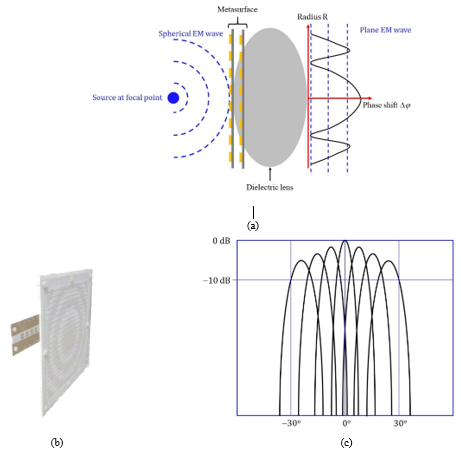
Figure 1. (a) conventional dielectric lens and metasurface-based metalens, and (b) prototype with seven feeding antennas and seven beams generated by the feeding antennas.
Design 2: It is challenging to apply lens antennas in lower microwave bands, for instance around 2 GHz, very popular frequency bands for 5G New Radio network. The application of lens antennas is naturally good candidates for the achievement of multiple beams within an existing antenna aperture. For instance, the conventional signle beam of halfpower-beamwidth of 90 degrees can be divided into three identical beams each of 30 degrees, pointing to the directions of 0 and 30 degrees.
Figure 2 shows a compact wideband wide-angle polarization-free metalens antenna array for a three-beam base station operating over the band of 1.71-2.2 GHz for 5G New Radio [6]. Figure 2a show the three beams with coverage of ±30° range compared with conventional single beam design.
Figure 2b shows the cross-section view of the metalens antenna. The five-layered metasurface consists of arrays of rectangular elements, which are relatively smaller for wideband, wide-angle, polarization-free, and reflectionless responses. The metalens is excited by three pairs of antennas of ±45° polarized cross-dipole antennas.
Within limited space the challenges include the miniaturization of the antennas, optimization of radiation patterns, and suppression of mutual coupling between the feeding antennas. With bent ground plane the three pairs of antennas symmetrically located generate the three beams in the directions of 0° and ±30° in a horizontal plane. As a section of array with 1×4 elements, the antenna achieves the isolation larger than 22.3 dB over an impedance bandwidth of 1.63-2.24 GHz for return loss ≥ 10 dB. The measured gain ranges / the sidelobe levels are 11.8-13.5 dBi / -22.6 dB for 0° beam and 10-12.2 dBi / -13.6 dB for 30° beams, respectively.
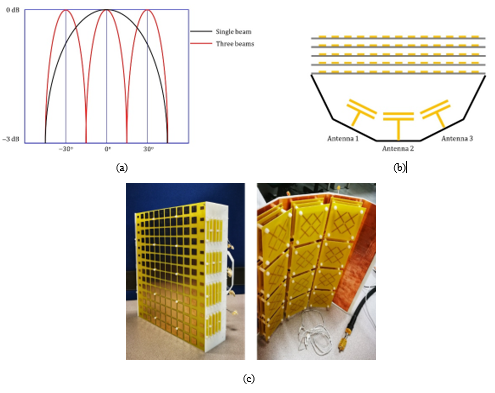
Figure 2. (a) Three beams vs single beam, (b) cross-section view of metalens antenna, and (c) photos of prototypes of three-beam metalens antenna.
Besides the design examples, there have been many lens technologies have been developed for high-gain and multi-beam applications for 5G network at microwave bands. Sharing the same principle as transmissive metalens antennas, the reflective metasurfaces have also been developed for high-gain applications. More selected references can be found in References [7-21] .
3.2 Metasurface Antennas
With the introduction of multiple mmW bands into 5G network, antenna design has more considerations. For instance, sharing the aperture of antenna is a promising way not to increase the aperture of antenna when the antennas operating at new mmW bands are integrated into the existing antennas operating at lower bands.
Design 3: Figure 3 shows a dual-band shared-surface antenna operating at both 5G 3.5-GHz and 28-GHz bands [22]. The antenna integrates a 33-unit-cell metasurface operating at the 3.5-GHz band and an 1818-unit-cell partially reflective surface at the 28-GHz band. The antenna simultaneously achieves the operations at both the 3.5-band and 28-band with 10-dB impedance bandwidth of 23.5% and 9.8% as well as the realized gain of 7.3 ~ 10.4 dBi and 11.8 ~ 14.6 dBi, respectively.
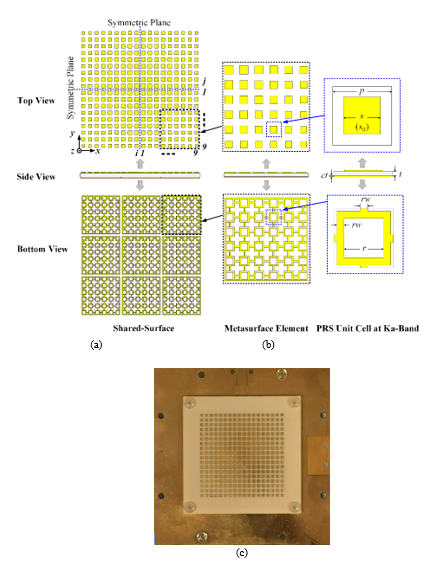
Figure 3. (a) Shared aperture, (b) metasurface, partial reflection sheet and their unit cells, and (c) the photo of antenna prototype. (The figures (a) and (b) from Ref. 22)
Importantly, the radiation patterns at both 3.5-GHz and 28-GHz bands keep unchanged as original designs as shown in Figure 4. It suggests that the operations at two bands share the same aperture without interference. This will benefit the designs operating at multiple bands for high integration of multiple antennas.
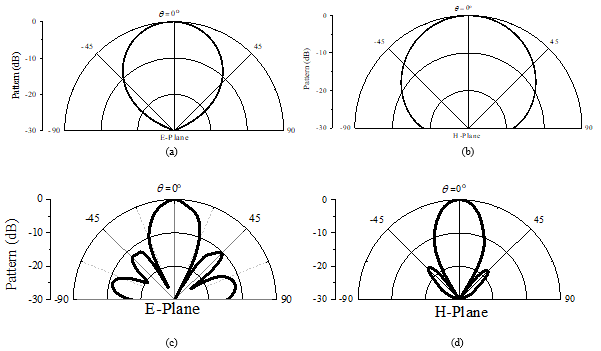
Figure 4. Normalized radiation patterns. (a) E-plane at 3.6 GHz, (b) H-plane at 3.6 GHz, (c) E-plane at 28 GHz, and (d) H-plane at 28 GHz.
Design 4: Figure 5(a) demonstrates a compact metasurface-based antenna with 3 × 3 square patch unit cells for 5G 28-GHz and 38-GHz bands [23]. Using a characteristic mode analysis (CMA), the patch unit cells of the antenna are modified and optimized to operate at three modes resonating at 28 GHz, 33 GHz, and 36 GHz, respectively. Excited by a substrate integrated waveguide feeding network, the proposed metantenna achieves the 10-dB measured impedance bandwidths of 23.7-29.2 GHz and 36.7-41.1 GHz as shown in Figure 5(b). the achieved gain reaches 4.8-7.2 dBi and 8.9-10.9 dBi over the two bands, respectively.

Figure 5. (a) Photo of prototype of the dual-band antenna and (b) |S11| GHz and gain for 3.6-GHz and (c) 28-GHz bands.
Similar to Design 3, the most challenging design consideration is to achieve consistent radiation patterns over the dual bands. Three modes operating with desired similar radiation patterns are selected to operate at the two bands based on the results by CMA. The three selected modes are excited to realize the patch-like radiation patterns over both the bands as shown in Figure 6.
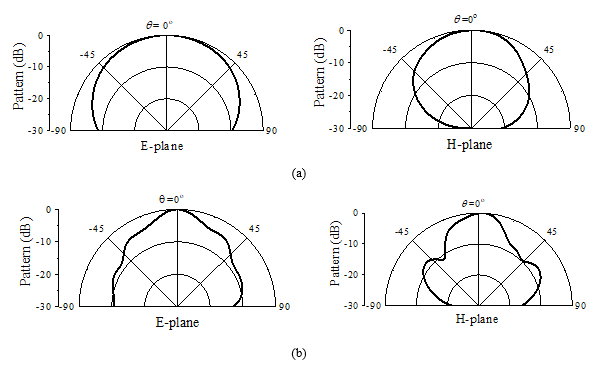
Figure 6. Normalized radiation patterns at (a) 26 GHz and (b) 38.5 GHz bands.
4. Conclusion
The antenna is the most classic technology in the history of radio engineering. Rapid development of applications has spurred the innovation of antenna technology because of the fact that the performance of antennas in classic forms has quickly approached their physical limits. With the realization of metamaterials, in particular, metasurfaces featuring unique EM properties, we have one more opportunity to invent new antennas, metantennas with enhanced performance, reduced volume, and even new functions.
In the past decade, our team has focused the research and development of metamaterial/metasurface/metaline based antennas, namely, metantennas at microwave bands for satellite communications (SatCom), automotive radar, radio-frequency identification (RFID), wireless local area network (WLAN), magnetic resonance imaging (MRI), and base stations of 5G network.
The fast evolution of wireless systems like 5G is advancing conventional antenna technology to the new generation at radiator and system levels. The development and adoption of new physical concepts and new mathematic methods such as metamaterials and artificial intelligent enabled design and optimization methods will definitely create the opportunities for the innovation of antenna technologies.
Acknowledgements
Thank all team members who have contributed to the work mentioned in this article. Special thanks go to Dr Teng Li from Southeast University, China and Karlsruhe Institute of Technology, Germany for his help in preparing the manuscript.
About Author Zhi Ning Chen (M’99-SM’05-F’07) received his BEng (1985), MEng (1988), and PhD (1993) degrees all in Electrical Engineering from the Institute of Communications Engineering (ICE), Nanjing, China and his second PhD (2003) degree from the University of Tsukuba, Tsukuba Japan, respectively.
Zhi Ning Chen (M’99-SM’05-F’07) received his BEng (1985), MEng (1988), and PhD (1993) degrees all in Electrical Engineering from the Institute of Communications Engineering (ICE), Nanjing, China and his second PhD (2003) degree from the University of Tsukuba, Tsukuba Japan, respectively.
In 2012, Dr Chen joined the Department of Electrical and Computer Engineering, National University of Singapore as a Professor and currently as Deputy Director of Advanced Research and Technology Innovation Center as the founder.
Dr Chen has published 680+ academic papers and six books and is holding 33 granted/filed patents. he is more interested in metasurfaces based antennas.
Dr Chen was elevated the Fellow of Academy of Engineering, Singapore in 2019 and a Fellow of the IEEE for the contribution to small and broadband antennas for wireless applications in 2007. Currently he is serving IEEE Future Networks Initiative Tech Focus Editorial Board as a member. He has served IEEE Council on RFID as a Distinguished Lecturer since 2016 and as a Vice President during 2015-2020. He severed IEEE Transaction on Antennas and Propagation as an Associate Editor and IEEE Antennas and Propagation Society as a Distinguished Lecturer as well as the members of Fellow Committee and New Direction Committee. (www.ece.nus.edu.sg/staff/bio/czn.html)
References
[1] Z. N. Chen and X. Qing (ed.), Substrate-Integrated Millimeter-Wave Antennas for Next-generation Communication and Radar Systems. IEEE Press /Wiley, May 2021
[2] Z. N. Chen and K. M. Luk (ed.), Introduction in Antennas for Base Stations in Wireless Communications. McGraw Hill, page xxi. 2009
[3] T. Li and Z. N. Chen, “Metantennas: MultiFunctional Metasurface Antennas,” International Conference on Electromagnetics in Advanced Applications (ICEAA), Granada, Spain, 9-13 Sept. 2019, pp. 121–125.
[4] Z. N. Chen, T. Li, M. Jiang, W. E. I. Liu, and X. Qing, “Millimeter-Wave Metantennas for 5G Wireless Communications (Invited),” IEEE Asia-Pacific Microwave Conference (APMC), Singapore, 2019, pp. 31-32, doi: 10.1109/APMC46564.2019.9038738.
[5] M. Jiang, Z. N. Chen, Y. Zhang, W. Hong, and X. Xuan, “Metamaterial-Based Thin Planar Lens Antenna for Spatial Beamforming and Multibeam Massive MIMO,” IEEE Transactions on Antennas and Propagation, vol. 65, no. 2, pp. 464-472, Feb. 2017, doi: 10.1109/TAP.2016.2631589.
[6] T. Li and Z. N. Chen, “Compact Wideband Wide-Angle Polarization-Free Metasurface Lens Antenna Array for Multibeam Base Stations,” IEEE Transactions on Antennas and Propagation, vol. 68, no. 3, pp. 1378-1388, March 2020.
[7] Y. Su and Z. N. Chen, “A flat dual-polarized transformation-optics beamscanning Luneburg lens antenna using PCB-stacked gradient index metamaterials,” IEEE Trans. Antennas Propag., vol. 66, no. 10, pp. 5088–5097, Oct. 2018.
[8] Y. Su and Z. N. Chen, “A radial transformation-optics mapping for flat ultra-wide-angle dual-polarized stacked GRIN MTM Luneburg lens antenna,” IEEE Trans. Antennas Propag., vol. 67, no. 5, pp. 2961–2970, May 2019.
[9] Z. N. Chen, Y. Su, and W. E. I. Liu, “Metantennas: Flat Luneburg Lens Antennas Using Transformation Optics Method (TOM),” International Workshop on Antenna Technology (iWAT), Bucharest, Romania, 25-28 Feb. 2020.
[10] S. Li, Z. N. Chen, T. Li, F. H. Lin and X. Yin, “Characterization of Metasurface Lens Antenna for Sub-6 GHz Dual-Polarization Full-Dimension Massive MIMO and Multibeam Systems,” in IEEE Transactions on Antennas and Propagation, vol. 68, no. 3, pp. 1366-1377, March 2020.
[11] C. Xue, Q. Lou, and Z. N. Chen, “Broadband Double-Layered Huygens’ Metasurface Lens Antenna for 5G Millimeter-Wave Systems,” in IEEE Transactions on Antennas and Propagation, vol. 68, no. 3, pp. 1468-1476, March 2020.
[12] M. Imbert, J. Romeu, M. Baquero-Escudero, M. Martinez-Ingles, J. Molina-Garcia-Pardo and L. Jofre, “Assessment of LTCC-Based Dielectric Flat Lens Antennas and Switched-Beam Arrays for Future 5G Millimeter-Wave Communication Systems,” in IEEE Transactions on Antennas and Propagation, vol. 65, no. 12, pp. 6453-6473, Dec. 2017, doi: 10.1109/TAP.2017.2767821.
[13] A. Dadgarpour, M. Sharifi Sorkherizi, and A. A. Kishk, “High-Efficient Circularly Polarized Magnetoelectric Dipole Antenna for 5G Applications Using Dual-Polarized Split-Ring Resonator Lens,” in IEEE Transactions on Antennas and Propagation, vol. 65, no. 8, pp. 4263-4267, Aug. 2017, doi: 10.1109/TAP.2017.270809.
[14] M. S. Rabbani, J. Churm and A. Feresidis, “Electro-Mechanically Tunable Meta-Surfaces for Beam-Steered Antennas from mm-Wave to THz,” 2020 50th European Microwave Conference (EuMC), Utrecht, Netherlands, 2021, pp. 416-419, doi: 10.23919/EuMC48046.2021.9338142.
[15] S. I. Naqvi, M. A. Azam, Y. Amin, J. Loo and H. Tenhunen, “Beam-Steerable Antenna Array with Metasurface at Millimeter Wave Frequency Range,” 2019 22nd International Multitopic Conference (INMIC), Islamabad, Pakistan, 2019, pp. 1-6, doi: 10.1109/INMIC48123.2019.9022785.
[16] M. Wu, K. Kosaka, and E. Hankui, “Reconfigurable Metasurface Lens Thin Antenna with 3-State Unit Cells in 28-GHz Band,” 2019 IEEE International Symposium on Antennas and Propagation and USNC-URSI Radio Science Meeting, Atlanta, GA, USA, 2019, pp. 1599-1600, doi: 10.1109/APUSNCURSINRSM.2019.8888622.
[17] M. Xue, W. Wan, Q. Wang, and L. Cao, “Low-Profile Millimeter-Wave Broadband Metasurface Antenna with Four Resonances,” in IEEE Antennas and Wireless Propagation Letters, doi: 10.1109/LAWP.2021.3053589.
[18] J. Yin, Q. Wu, Q. Lou, H. Wang, Z. N. Chen, and W. Hong, “Single-Beam 1 Bit Reflective Metasurface Using Prephased Unit Cells for Normally Incident Plane Waves,” IEEE Trans. Antennas Propagat., vol. 68, no. 7, pp. 5496-5504, July 2020.
[19] Z. N. Chen, T. Li, and W. E. I. Liu, “Microwave Metasurface-based Lens Antennas for 5G and Beyond,” 14th European Conference on Antennas and Propagation (EuCAP 2020), Copenhagen, Denmark, March 15-20, 2020.
[20] Z. N. Chen, “Microwave Metalens: A Classic but New Antenna Solution,” 2020 Asia-Pacific Microwave Conference (APMC), 8-11 December, 2020 Hong Kong, China
[21] C. Xue, Q. Lou and Z. N. Chen, "Broadband Double-Layered Huygens’ Metasurface Lens Antenna for 5G Millimeter-Wave Systems," in IEEE Transactions on Antennas and Propagation, vol. 68, no. 3, pp. 1468-1476, March 2020, doi: 10.1109/TAP.2019.2943440.
[22] T. Li and Z. N. Chen, “Shared-Surface Dual-Band Antenna for 5G Applications,” in IEEE Transactions on Antennas and Propagation, vol. 68, no. 2, pp. 1128-1133, Feb. 2020, doi: 10.1109/TAP.2019.2938584. (sub-6GHz+28GHz)
[23] T. Li and Z. N. Chen, “A Dual-Band Metasurface Antenna Using Characteristic Mode Analysis,” in IEEE Transactions on Antennas and Propagation, vol. 66, no. 10, pp. 5620-5624, Oct. 2018, doi: 10.1109/TAP.2018.2860121.
Subscribe to Tech Focus
Join our IEEE Future Networks Technical Community and receive IEEE Future NetworksTech Focus delivered to your email.
Article Contributions Welcome
Submit Manuscript via Track Chair
Author guidelines can be found here.
Other Future Networks Publications
IEEE Future Networks Tech Focus Editorial Board
Rod Waterhouse, Editor-in-Chief
Mithun Mukherjee, Managing Editor
Imran Shafique Ansari
Anwer Al-Dulaimi
Stefano Buzzi
Yunlong Cai
Zhi Ning Chen
Panagiotis Demestichas
Ashutosh Dutta
Yang Hao
Gerry Hayes
Chih-Lin I
James Irvine
Meng Lu
Amine Maaref
Thas Nirmalathas
Sen Wang
Shugong Xu
Haijun Zhang
Glaucio Haroldo Silva de Carvalho

